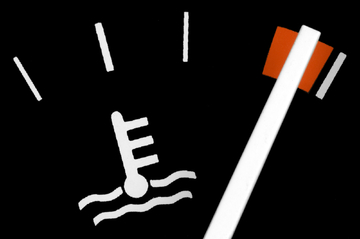
One of the worst things that happen when a car breaks down is overheating. A car’s engine uses a mixture of water and antifreeze, also called coolant, to carry heat from the engine and cool it through the car's radiator. In most modern cars, this process works so well that most drivers won’t ever have a problem.
That wasn’t always the case. Overheating was such a common problem in the old days that many highways have non-potable water wells every few miles to aid motorists whose cars overheated. An overheating car cannot be driven until it cools down. Continuing to drive a car that is overheating is a sure way to cause engine failure. The metal gets so hot that it distorts and can crack, seize, or blow a gasket. In some cases, repairing a blown engine from overheating will cost more than the car is worth.
Antifreeze, Coolant, and Modern Radiators
Antifreeze and coolant are terms used synonymously. This stuff is pretty remarkable because it both prevents water from freezing and keeps water from boiling. Automotive parts stores will usually carry several different types of antifreeze and coolant. A workshop manual will list the type of antifreeze recommended for a particular vehicle.
It used to be that all antifreeze was the same. The old stuff, which hot-rodders and muscle car fanatics still swear by, was a vivid green color and contained ethylene glycol, a poisonous compound that helps raise the boiling point of water. Commonly, radiators were made of brass and copper, metals that dissipate heat rather well. The antifreeze was mixed 50/50 with water.
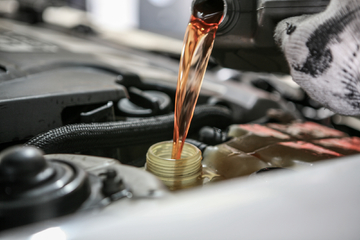 Use a Workshop Manual for the vehicle to determine what type of coolant to use.
Use a Workshop Manual for the vehicle to determine what type of coolant to use.Today, many cars use a different formulation of antifreeze that is colored bright orange. Do not ever mix the two types, as they are not compatible. Most cars today use a radiator primarily made of composite plastic materials. These are more difficult to repair, but often cheaper to replace than the old-style radiators.
Antifreeze is sold concentrated, so the do it yourself mechanic can mix it themselves, or it is sold pre-mixed. It is usually sold in a gallon jug.
Signs of a Problem
Drivers that take the time to maintain their cars will often see evidence of small leaks around the radiator. This could be liquid dripping, but often, a leaking radiator will show dry, almost powdery trails of green or white. This is the remains of coolant and is an indicator that the car's radiator is not holding pressure correctly.
Coolant has a very distinct smell when it gets too hot. It can be described as burnt-sweet smelling, sticky smelling, or bitter.
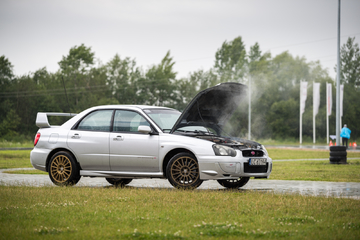 Often, the first sign of overheating is steam from boiling water escaping the cooling system.
Often, the first sign of overheating is steam from boiling water escaping the cooling system.Cars have a temperature gauge that helps to let drivers know when the temperature of the coolant is getting too hot. Most cars these days are intended to operate with the temperature gauge about midway between hot and cold. When the gauge starts to climb above the midway point on the gauge toward hot, it is time to figure out what is happening.
If the gauge suddenly goes from normal to hot, drivers need to shut the car off immediately and pull safely to the side of the road. Attempting to continue driving a car that is “pegging” the temperature gauge will almost certainly result in catastrophic engine failure.
Damage caused by an overheated engine will be obvious. The engine will bang, rattle, and shake, and may have internal components shatter and explode, tearing right through the side of the engine. This will require a full replacement of the engine to repair, a process that can easily exceed $5,000.
Reasons a Car will Overheat
Sometimes, an overheating issue can be addressed quickly and easily. Other times, it will take a lot more work, time, and money to get the car running right again.
First things first, check the coolant level. Do this when the car is cool. Opening the radiator cap when the engine is hot is dangerous. The water is under pressure in the radiator and removing the cap will allow that pressure to escape instantly, along with all the boiling water and antifreeze. This can cause severe burns, blindness, and all sorts of painful injuries.
Checking the Coolant
If the coolant level is normal, there may be another problem. Sometimes a radiator can become plugged with debris, blocking off passages and preventing water from freely circulating in the radiator. Sometimes, a radiator flush can help this situation. A flush is essentially a chemical cocktail that is poured into the radiator, driven for a short time, then drained and refilled with clean antifreeze. This removes calcium build-up, scum, and other contaminants.
If the coolant is low, adding it may reduce the overheating issue, but drivers must still find out what happened to the rest of the coolant. The system is designed to be a closed circuit, and there is no such thing as normal loss.
Finding Leaks
Common places for coolant leaks are the hoses that connect the radiator to the engine and the car's heater. These rubber hoses are exposed to extreme temperatures and can crack or wear out, allowing coolant to escape and causing an overheating issue. The home mechanic can identify worn out hoses by looking for bulges, cracks, and wetness. It is a good idea to periodically replace radiator and heater hoses, and it is a simple, straight forward job anyone can do.
The Water Pump and Radiator Inspection
Coolant is circulated through the engine by a water pump, usually driven by a belt on the front of the engine. Sometimes, this belt will break or slip off, and this can be a cause of overheating. A belt that slips off should be replaced as soon as possible. Do not drive a car with a broken water pump belt. It will overheat very quickly and destroy the engine.
The water pump will eventually wear out on all cars. Typically when a water pump wears out, a small amount of coolant will dribble out of a vent hole near the shaft. This is a sign of a worn-out pump. The pump can also be checked by removing the belt and lifting up and down on the shaft. There should be no movement. If the shaft can be moved up and down, replace the pump.
The flow of water through an engine is controlled by the thermostat. Thermostats are typically located at the top of the engine near the upper radiator hose. Thermostats use a metallic spring that expands and contracts with temperature changes, allowing more water to flow when the engine is hot. Old-school racers used to remove them, but this is not recommended for regular use cars or any modern vehicle. A thermostat and gasket are inexpensive items that are easily changed. It is best to replace the thermostat any time repairs are made to the cooling system, as the coolant will have to be drained and refilled to service the thermostat.
If wetness or coolant is seen around the seams of the radiator, it is likely to be leaking, and the radiator will need to be repaired or replaced. Typically, a radiator repair will cost around $100. Replacement radiators can cost from a few hundred dollars to almost $1,000 on expensive models.
The cooling system is a closed and pressurized set-up. This allows the water to exceed its typical boiling point. The pressure is regulated and maintained by the radiator cap. Radiator cap pressure is usually indicated on the cap and can be verified in a service manual. Replace periodically to ensure a well-pressurized system.
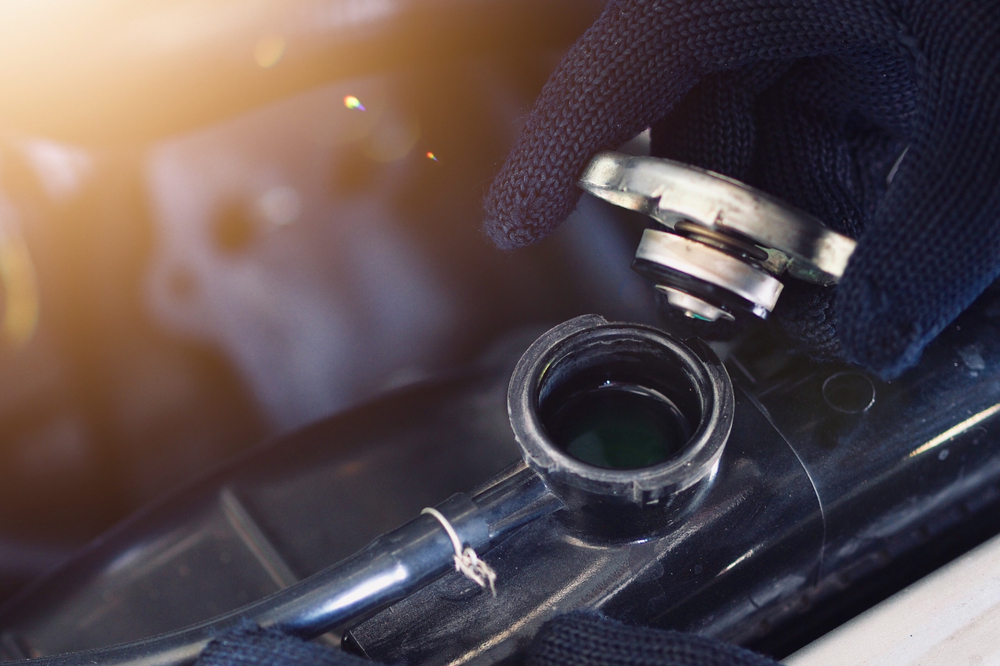 Only remove the radiator cap when the engine is cool. Otherwise, it can shoot boiling water at you.
Only remove the radiator cap when the engine is cool. Otherwise, it can shoot boiling water at you.Head Gasket Failure
The most destructive reason for overheating is a blown head gasket. A head gasket is a piece of material that seals the engine block to the cylinder head and prevents burned gases from mixing with oil and water. This gasket will eventually wear out, but often it fails when a car is allowed to run at too hot a temperature for too long. High-performance cars and off-road vehicles are more likely to blow a head gasket.
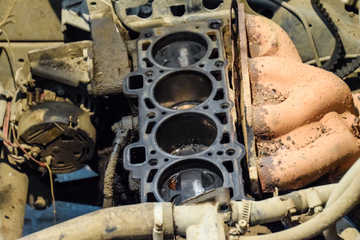 Replacing a blown head gasket is a difficult job that can be avoided by preventing overheating.
Replacing a blown head gasket is a difficult job that can be avoided by preventing overheating.The easiest way to diagnose a probable head gasket failure is to look at the exhaust when the car is started cold. Thick, white smoke indicates the car is burning coolant. The home mechanic should look at the engine oil dipstick. Water and oil do not mix, and a blown head gasket can allow water to enter the oil pan. It will look like whitish foam or slime on the dipstick.
A compression test is the best way to determine a blown head gasket. This is a gauge that is threaded in where the spark plugs are installed. Cranking the engine will show how much pressure each cylinder will hold. A blown head gasket will show because two cylinders side-by-side will have low pressure.
Replacing a head gasket is a complicated procedure, but it is not impossible. An average person, armed with a service and repair manual for their vehicle can remove the cylinder heads and replace the gasket in a weekend on most vehicles.
Repair costs for a head gasket replacement at a shop will vary based on the car but expect to pay at least $1,500. Complex cars that require removal of other equipment to get at the heads will cost substantially more, as will head gasket repair work on high-performance vehicles.
Engines with aluminum cylinder heads should be monitored carefully for overheating issues. Aluminum and cast iron expand at different rates, and overheated aluminum will warp where cast iron will crack. Warped heads will need to be serviced by a machine shop to get them to seal correctly. It is recommended to have the heads inspected any time the car has suffered a serious overheating situation like a blown head gasket. Sometimes, cracked heads can be welded, but often should be replaced.
Preventative Maintenance
The best way to keep a car from overheating is to regularly check the coolant. If it is low or dirty looking, simply flushing and replacing it can prolong the life of the system. Regularly inspect belts and hoses and replace them as needed. Cleaning the fins of a radiator from leaves and bugs will improve its efficiency. If a car smells hot after driving for a while, it should be thoroughly inspected for leaks and failures.
Tips for Dealing with a Hot Car
Drivers often find themselves in less than ideal situations when a car starts to overheat. Start by turning off the A/C to reduce the work the cooling system must do. Drive slower and try not to accelerate hard. It is not recommended to pour cool water on the radiator, nor should you put cold water in a hot radiator. This can crack hot metal parts. Pouring water on the radiator can lead to electrical problems when the water enters plugs and connectors and contaminates them. If the car is just getting more hot than usual but is not going to the top of the gauge, running the heater can help. Driving a car that is overheating is a very stressful situation. In most cases, it is better to call a tow truck than risk driving and destroying the car.
